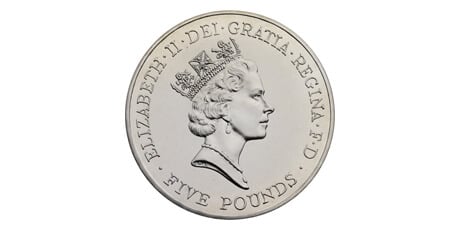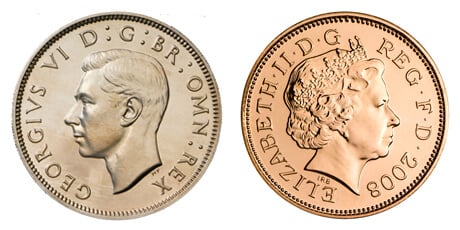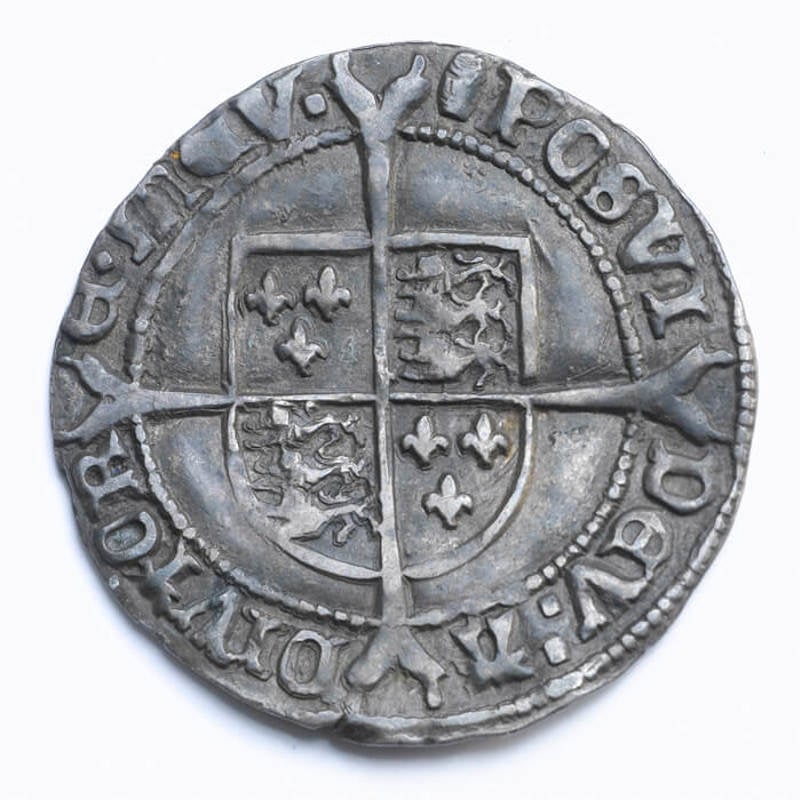The Royal Portrait
Changes in the royal portrait occur but rarely on United Kingdom coins. Even during the long reign of Queen Victoria there were no more than five portraits, one of which enjoyed such royal favour that it continued to be used for some 50 years. Similarly, only five standard effigies of Her Late Majesty Queen Elizabeth II were used on the United Kingdom coinage during her reign.
Mary Gillick
The first of these effigies was the portrait by Mary Gillick. This shows Her Majesty wearing a wreath in the style of many British coins struck between the 17th and early 19th centuries. It remained in use for United Kingdom coins until decimalisation, and appears on the special silver coins minted each year for the Royal Maundy.

Arnold Machin
For the decimal coins, the first of which entered circulation in 1968, a fresh portrait by Arnold Machin was adopted. Like Mary Gillick, he avoided the couped portrait cut off at the neck which had been usual on coins earlier in the century. The wreath, however, he replaced with the tiara of festoons, scrolls and collet-spikes which had been given to the Queen Elizabeth II as a wedding present by Queen Mary.

Raphael Maklouf
The effigy selected for use from 1985 was prepared by the sculptor Raphael Maklouf. Having worked originally from photographs, he was granted two sittings by the Her Majesty in order to make minor adjustments to the portrait. It shows Queen Elizabeth II with the royal diadem which she wore on her way to and from the State Opening of Parliament, and includes a necklace and earrings.

Ian Rank-Broadley FRBS
There was, deliberately, a classic timelessness about the Maklouf design, but for the fourth portrait, adopted at the beginning of 1998, a greater degree of realism was introduced. This is the work of the sculptor Ian Rank-Broadley who, because coins have become smaller, wanted the portrait to fill as much of the field as possible.

Jody Clark
The last coinage portrait designed by Royal Mint engraver Jody Clark shows Queen Elizabeth II with the Royal Diamond Diadem Crown, which she wore for her Coronation in 1953. Clark chose this regalia as a nod to the past as it was featured in the designs by both Raphael Maklouf and Arnold Machin.

Continuing tradition
In accordance with a tradition which can be traced back to the 17th century successive monarchs face in alternate directions on the coinage. Some have claimed to see the origins of this tradition in the desire of Charles II to turn his back on Oliver Cromwell. Such a convenient explanation is unlikely and it may be better to concede that if any practical or political reason ever existed it has long since been forgotten.

Find out more about Mary Gillick and her portrait of Queen Elizabeth II in this discussion which was streamed live on May 31, 2022. The talk celebrated Her Majesty The Queen's Platinum Jubilee, for which the British Museum produced a display, Mary Gillick: modelling The Queen's portrait (2 June – 3 July 2022). The shows curator Philip Attwood is joined by Dr Kevin Clancy, Director of the Royal Mint Museum, and Alessandro Nasini of the Royal Collection Trust, to consider how this image of Queen Elizabeth II was designed and struck in coinage. They also explore how it fits in with the development of Her Majesty's image over her 70-year reign, especially through photography.
You might also like

Arnold Machin
Machin designed the royal portrait which featured on United Kingdom decimal coins from 1968-84.

Double Portraits on the Coinage
The first English coins to bear a double portrait were issued during the reign of Mary I.

Coins of Jordan
The Royal Mint has a long relationship with Jordan stretching back to the first national coinage.

